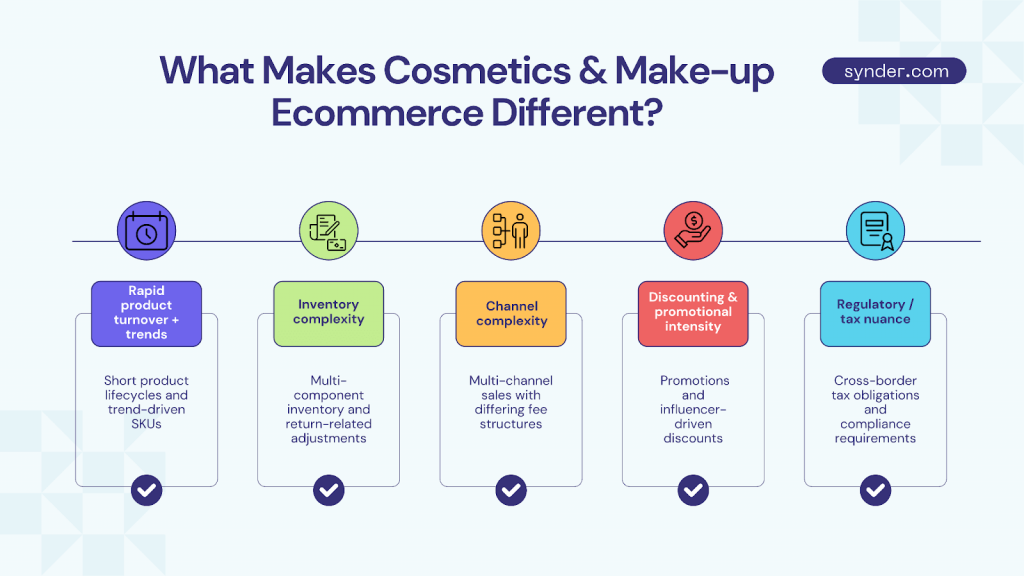The cosmetics business isn’t all moodboards and mica pigments. Actually, it’s math in mascara packaging. Every foundation shade, or every refill subscription, has a financial consequence. You can have 200 shades of lipstick, but if you don’t know which twelve actually pay the bills, you’re running a very pretty guessing game.
Cosmetics and accounting don’t seem like a natural match, but one funds the other. This guide is about that second, less photogenic side of the industry: how make-up brands measure profit per product, track refunds without distorting revenue, recognize subscription income properly, stop inventory from dying on shelves, and use automation tools like Synder to make sure their numbers are as polished as their packaging.
TL;DR
Here are quick takeaways if you’d rather get the essentials upfront.
- In cosmetics and make-up eсommerce, success isn’t only about selling, but also about knowing which products actually make money after fees, returns, tax, and COGS.
- Most issues start when accounting is manual: inventory goes missing, payouts don’t match sales, taxes are misreported, and what you thought as “bestsellers” turn out unprofitable.
- Manual accounting just can’t keep up with the pace of cosmetics and make-up ecommerce; automation is what turns scattered numbers into trustworthy financials.
- Synder is the go-to solution for beauty brands that want real numbers, syncing sales, fees, inventory, subscriptions, and taxes from 30+ platforms straight into their accounting system.
And now we’ll get into details.
What makes cosmetics & make-up ecommerce different?

While many of the core accounting principles for ecommerce apply, the beauty category adds extra layers:
- Rapid product turnover + trends: Colour palettes, seasonal launches, influencer-led drops mean you may have many SKUs with short lifespans.
- Inventory complexity: Finished goods, parts (palettes, applicators), packaging, sample sets, plus the possibility of spoilage, returns, or obsolescence (expired product).
- Channel complexity: You might sell via your own website, Amazon, beauty retailers, affiliates, each with unique fees and payout structures.
- Discounting & promotional intensity: Flash sales, samples, bundles, influencers – the cost side of promotions needs tight tracking.
- Regulatory / tax nuance: Beauty products may cross borders; you may face import duties, multiple sales-tax jurisdictions, marketplace facilitator rules, and product labelling cost implications.
Understanding these differences from the start helps you set up your accounting in a way that actually fits your business.
Core accounting components for cosmetics ecommerce
Here are the key building blocks you should make sure are grounded properly:
Sales and revenue recognition
Track all sources of income: online store, marketplace, wholesale, and subscriptions. Decide whether to use cash basis or accrual basis: for a brand with inventory and many demand channels, accrual accounting often gives a clearer picture. Make sure you capture returns, discounts, influencer-driven credits, gift cards, and other loyalty-program liabilities.
Cost of goods sold (COGS) & inventory valuation
In cosmetics, you’ll need to track reliably:
- purchase cost of products + packaging + freight + import duties + QC/spoilage.
Then, when a product is sold, you allocate COGS. Inventory valuation and turnover become vital metrics: dead stock costs money. Discounts and bundles should have their cost reflected too (not just the sale price).
Expenses & overhead
Operational costs in a beauty ecommerce brand can include: influencer marketing, product development, packaging design, fulfilment fees, returns processing, warehousing for multiple SKUs, and promotions.
Ensure these are clearly separated from product costs. Use a well-designed Chart of Accounts (for example: “Influencer marketing”, “Promotional samples”, “Packaging redesign”) so you can analyse spend by campaign or SKU-group.
Sales tax / VAT / international tax compliance
If you’re selling across states or countries, you must understand nexus rules (in the U.S.) and VAT/Import duties (outside). For beauty brands shipping globally, this becomes more acute: multiple sales-tax regimes, varying duty/tariff regimes, and marketplace-collected tax.
Financial reporting & insight
You don’t just need your books to be “done”. You need them to tell a story. A beauty brand needs to see which products actually bring profit, not just which ones sell. That means knowing your gross margin per SKU or product line, how quickly your palettes, lip kits, or skincare sets move through inventory, and which sales channel delivers the highest profitability, not just the highest volume.
Common accounting pitfalls in cosmetics & make-up ecommerce
Beauty brands often struggle with messy accounting behind growing operations. Here are the most common traps cosmetics and make-up businesses fall into:
Inventory is growing, but no one knows what’s actually selling or sitting
With hundreds of SKUs, seasonal launches, and multiple shades, inventory quickly becomes complex. Many brands don’t track which products move fast and which sit until they expire. Inventory looks good on the balance sheet, but in reality, a large portion is unsellable or dead stock.
Returns, damaged goods, and expired stock are recorded only partially
Make-up breaks in transit, skincare expires, customers return foundations that don’t match their tone, but many brands record only the refund and forget to adjust inventory or COGS. As a result, their books still show inventory that no longer exists and profits that were never actually earned.
Discounts and influencer promotions make margins look healthier than they are
Beauty brands run constant promos, like PR boxes, bundle discounts, and giveaways. These are often treated as “just marketing”, but if they’re not properly classified as expenses or contra-revenue, the financial reports will show inflated sales and unrealistically high profit margins.
Sales across multiple channels make true profitability hard to see
A brand selling through Shopify, Amazon, TikTok, and wholesale often ends up with scattered data. Amazon fees, Stripe processing costs, TikTok commissions, and fulfillment fees get buried in payout totals or missed entirely. With no breakdown, a best-selling lipstick shade on one platform may actually be losing money after all fees.
Sales tax and VAT obligations go unnoticed until it’s too late
As soon as a brand ships across U.S. states or internationally, tax obligations kick in, but many beauty founders only collect tax on their website and forget about marketplaces. Later, as sales grow, they discover unfiled tax liabilities in multiple jurisdictions.
Manual reconciliation slows everything down and hides mistakes
When payouts from Shopify or Amazon land in the bank, they don’t match sales totals because of fees, refunds, and shipping costs. Many businesses try to match numbers manually, line by line. This leads to mismatched deposits, missed expenses, and hours lost every week fixing spreadsheets instead of focusing on growth.
How to solve the biggest accounting challenges in cosmetics & make-up ecommerce
All of the issues above have the same root cause: too much manual work and too many disconnected systems. Automation fixes that by keeping every sale, fee, return, tax, and inventory update in sync. Synder is one of the tools that can be used specifically for this reality in beauty ecommerce. It brings all financial data from 30+ ecommerce channels and payment processors, like Shopify, Amazon, Stripe, or PayPal, into one clean, reliable flow.
Here’s how it tackles each challenge:
| Problem | How Synder fixes it |
| Returns and damaged items, not properly reflected in books | Synder syncs refunds and chargebacks to the original sale, automatically reversing income, tax, and, if inventory tracking is enabled in your accounting system, adjusting COGS and inventory. |
| Misclassified promotions, free samples, influencer codes affecting margins | Synder captures discounts and gift card transactions correctly. It posts them to specific accounts, so your true margins aren’t blurred. |
| Multiple channels (Shopify, Amazon, Stripe) → scattered fees & unclear profitability | Synder records the full sale amount, logs the payment processor’s fee as an expense, and then matches the net payout to your bank deposit. |
| Inventory chaos: too many SKUs, wrong stock levels, expired make-up | With Per Transaction Sync, Synder supports accurate COGS and inventory accounting by automatically syncing sales, product costs, and stock adjustments into your accounting system. |
| Sales tax/VAT surprises when selling across states or overseas | Synder posts sales tax or VAT to the proper Sales Tax Liability account in your books. If marketplaces collect and withhold the tax themselves, Synder records it separately. |
| Manual reconciliation: payouts don’t match what’s in QuickBooks/Xero due to hidden fees | Synder automatically pulls full order and payment details from your sales channel and payment processor, then reconciles every fee, tax, refund, and net payout so your accounting system exactly reflects what your bank sees. |
Why automation with Synder matters for cosmetics and make-up brands
With 30+ direct integrations, such as Shopify, Amazon, TikTok Shop, Stripe, PayPal, Square, and more, Synder unifies every sale, fee, refund, and tax adjustment into one reliable flow of information.
Here’s where automation truly elevates accounting for cosmetics ecommerce:
- Smart Rules let you adapt automation to your workflow, categorizing influencer collaborations, separating wholesale orders, or routing refill subscriptions to deferred revenue automatically.
- Multi-entity support enables consolidated accounting across multiple brands, regions, or subsidiaries, keeping books consistent while preserving individual performance visibility.
- Multi-currency support ensures accurate exchange rate handling and clean reporting for international transactions.
- Streamlined reconciliation means Synder structures data so that your books are clean, accurate, and ready for one-click reconciliation in QuickBooks, Xero, or ERP systems, freeing about 40 hours a month for product launches, lab work, partnerships, or marketing instead of spreadsheets.
- Revenue recognition ensures Synder RevRec directly integrates Stripe with QuickBooks Online, Sage Intacct, NetSuite, or Xero, automating the recognition of subscription and prepaid income over time in full compliance with ASC 606 standards. For businesses using other systems, Synder provides an Excel import option to upload subscription and transaction data, ensuring accurate revenue tracking across platforms.
- Audit-ready transparency enables you to track every figure in your reports back to its original transaction, building confidence with investors and accountants alike.
Ready to see your numbers as clean as an untouched palette? Start a 15-day free trial or book a 1:1 demo, and let Synder show you exactly which shades make money and which just make noise.
Conclusion – beautiful books for a beautiful industry
In cosmetics and make-up ecommerce, great branding might sell a product, but clean numbers keep the business alive. Synder turns all of that chaos into clarity. Every order, fee, refund, tax, subscription, and payout gets synced into your accounting system automatically, so profit per shade, cash flow, subscription revenue, and inventory costs start being facts. Because creativity builds the brand, but accurate accounting keeps it running.
If you’re scaling a cosmetics or makeup business and want your numbers as polished as your products, Synder is the backbone that makes it possible.
FAQ
Why is accounting more complex for cosmetics and make-up ecommerce brands?
Accounting becomes more complicated in this industry because cosmetics and make-up brands deal with fast-changing trends, hundreds of SKUs (with shades, bundles, samples, refills), frequent promotions, and multiple sales channels. Every return affects your margins and inventory levels. And without structured, automated accounting, those numbers quickly become fragmented and unreliable, which is exactly what Synder helps prevent by keeping sales, refunds, inventory, and COGS in sync.
How do I calculate profit per SKU or shade in cosmetics ecommerce?
To get real profit per SKU, you need to track more than sales. Include product cost, packaging, shipping, platform fees (Shopify, Amazon, etc.), discounts, taxes, and refunds. Tools like Synder automatically pull these details into your accounting system and let you track profit per shade, collection, or channel instead.
How should returns be handled in accounting?
Many cosmetics and make-up brands record only the refund, but proper accounting requires reversing the revenue, adjusting COGS, and updating inventory to reflect that the product came back. Synder automates this by linking the return to the original sale and posting the correct revenue, tax, COGS, and inventory adjustments, so your books don’t show profit or stock that isn’t actually there.
What’s the best way to track subscriptions?
Subscriptions shouldn’t be recognized as revenue when cash is received. Synder RevRec automates this by integrating Stripe with QuickBooks Online, Sage Intacct, NetSuite, or Xero, spreading subscription income over time in line with ASC 606. For other systems, you can upload data via Excel import to keep revenue tracking accurate.
Do I really need accounting automation, or can spreadsheets work?
Spreadsheets work in the beginning, but once you sell across platforms, offer discounts, process returns, or manage hundreds of SKUs, manual accounting becomes a chore. Numbers get out of sync, payouts don’t match sales, tax liabilities are missed, and profitability per product is unclear. Automation tools like Synder keep everything synced in real time, reduce errors, and show exactly which products make money.






